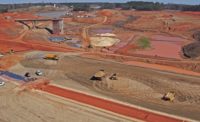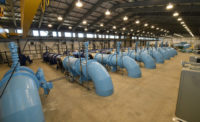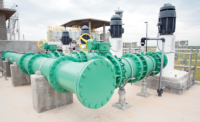Mt. Soma Reservoir
Bel Air, Md.
BEST PROJECT
Owner: Maryland American Water
Lead Design Firm: Gannett Fleming
General Contractor: Allan Myers
Environmental Linings: Hallaton
Concrete: Premier Concrete
Maryland’s largest dam project in 30 years, which features an innovative bituminous geomembrane liner, “blazes a new trail for the design of water storage reservoirs in the U.S.,” the team says.
The $6.3-million project required finding solutions for many site challenges. “To confirm that the mica-rich soil at Mt. Soma could be used for the embankment despite the variability of test results, the team challenged routine geotechnical practices,” according to the project team.
Instead of estimating an average curve, which is customary practice, the team says it developed a family of compaction curves applicable to the onsite soil. They also completed 50 additional lab water content tests, which exceeded what was specified in the contract. That helped avoid wasting material and saved up to $1 million, according to the project team.
The team says it introduced a global innovation to the community with its selection of a bituminous geomembrane liner to prevent seepage inside the 2,025-ft-long dam embankment and reservoir bottom. The highly flexible and durable BGM liner has a friction angle of 34 degrees, which is well-suited for most embankment slopes.
More prevalent in Europe, BGM liners are limited in use in the U.S., where they are used mostly in the mining industry. “The liner’s dimensional stability provides permanent contact with substrate, making it ideal for differential soil settlement, which is common during embankment construction,” the team says.
The team also chose to use sustainable water-quality improvement systems to maintain quality and hinder algae growth. “At Mt. Soma, seven man-made floating wetland units hold 4,000 native aquatic plants and cover 3,000 sq ft of the reservoir’s surface, enhancing the aesthetics of the facility while serving an important function,” the team says.
The systems rely on a solar-powered, ultrasonic algae-control system that removes up to 90% of existing algae in the water and inhibits new growth. A solar-powered water mixer promotes oxygenation and prevents stagnation to maintain water quality.
One judge said, “They used a very innovative material … that hasn’t been used in the U.S., and that’s always something that’s really tricky. In the water, wastewater industry it’s always safer to go tried and true.”
The use of natural wetlands and solar-powered control and mixing systems “helps alleviate environmental concerns and reduce chemical usage and related costs by an estimated 20%,” the team says. Of the project’s overall benefits, another judge said that “it really supported the community since previously they were relying on another township for their water supplies.”
Back to "MidAtlantic's 2019 Best Projects Shine Across The Region"








Post a comment to this article
Report Abusive Comment